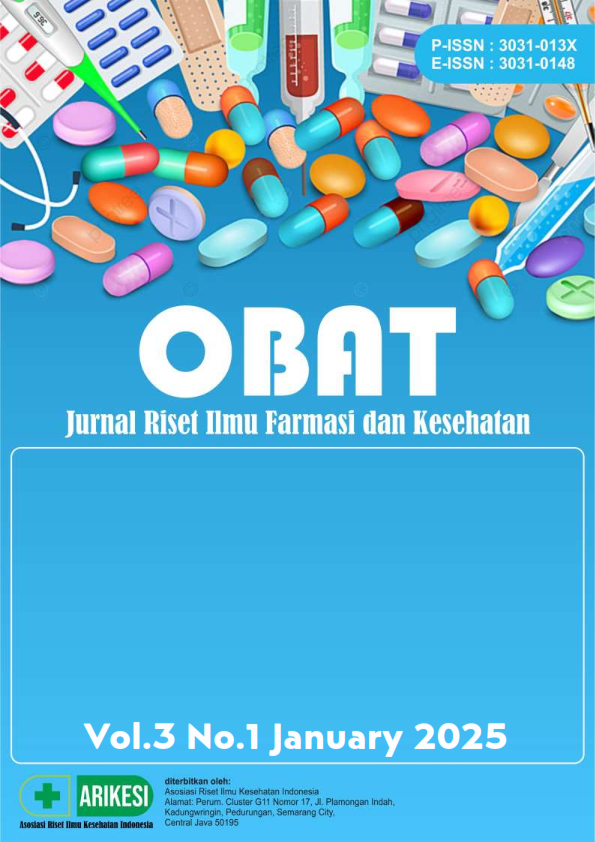Isolasi dan Karakterisasi Minyak Asiri Jeruk Nipis menggunakan GC-MS dan Aktivitasnya terhadap Bakteri Patogen Kulit
DOI:
https://doi.org/10.61132/obat.v3i1.925Keywords:
antibacteria, GC-MS, lime peel essential oil, Kirby-BaurerAbstract
In the fruit processing industry, peel is one of the main by-products. Non-edible portions of fruit are likewise seen as waste and are frequently thrown out into the environment. Nowadays, one of the main sources used by the pharmaceutical sector to isolate and extract secondary metabolites is fruit peels. Many applications known for lime peel, especially for antibacterial. This study focuses on the isolation, chemical composition characterization, and antibacterial activity on skin pathogenic bacteria of lime peel essential oil (LPEO). LPEO were isolated using steam distillation and characterized by GC/MS. A total of 24 components were identified. The major constituents of the LPEO were d-limonene (40.24%), β-terpinene (15.68%), sabinene (13.15%), citral (3.41%), α-Terpineol (3.40%), and terpinene-4-ol (2.94%). The antibacterial activity was determined using the Kirby-Baurer method against several bacteria that can cause skin infections. The antibacterial activity of LPEO against Escherichia coli, Staphylococcus aureus, Staphylococcus epidermidis dan Propionicbacterium acne is confirmed. LPEO showed varied levels of antibacteria activity against the gram positive and gram negative bacteria. Zone of inhibition (ZOI) in millimetres was used to measure the antibacterial activity, and amoxicillin was used as a control.
Downloads
References
Aini, N., Permatasani, B., Khasanah, U., & Sukmawati, A. (2018). Antimicrobial activity of lime juice (Citrus aurantifolia) against Propionibacterium acnes and Staphylococcus epidermidis. December 2017. https://doi.org/10.1166/asl.2017.10788
Al-Sayed, E., Gad, H. A., & El-Kersh, D. M. (2021). Characterization of four Piper essential oils (GC/MS and ATR-IR) coupled to chemometrics and their anti-Helicobacter pylori activity. https://doi.org/10.1021/acsomega.1c03777
Anwar, T., Qureshi, H., Fatima, A., Sattar, K., Albasher, G., & Kamal, A. (2023). Citrus sinensis peel oil extraction and evaluation as an antibacterial and antifungal agent.
Basnett, P., Marcello, E., Lukasiewicz, B., Nigmatullin, R., Paxinou, A., Ahmad, M. H., Gurumayum, B., & Roy, I. (2020). Antimicrobial materials with lime oil and a poly(3-hydroxyalkanoate) produced via valorisation of sugar cane molasses. Journal of Functional Biomaterials, 11(2). https://doi.org/10.3390/jfb11020024
Byrd, A. L., Belkaid, Y., & Segre, J. A. (2018). The human skin microbiome. Nature Reviews Microbiology, 16(3), 143–155. https://doi.org/10.1038/nrmicro.2017.157
Galovičová, L., Borotová, P., Vukovic, N. L., Vukić, M., Kunová, S., Hanus, P., Kowalczewski, P. Ł., Bakay, L., & Kačániová, M. (2022). The potential use of Citrus aurantifolia L. essential oils for decay control, quality preservation of agricultural products, and anti-insect activity. Agronomy, 12(3), 1–12. https://doi.org/10.3390/agronomy12030735
Gamarra, F. M. C., Sakanaka, L. S., Tambourgi, E. B., & Cabral, F. A. (2006). Influence on the quality of essential lemon (Citrus aurantifolia) oil by distillation process. Brazilian Journal of Chemical Engineering, 23(1), 147–151. https://doi.org/10.1590/S0104-66322006000100016
Guenther, E. (1987). Minyak asiri jilid I. Universitas Indonesia.
Haggag, E. G., Abdel Wahab, S. M., El-Zalabany, S. M., Abou Moustafa, E. A., El-Kherasy, E. M., & Mabry, T. J. (1998). Volatile oils and pectins from Citrus aurantifolia (lime) and Citrus limonia (lemon). Asian Journal of Chemistry, 10(4), 828–833.
Hsouna, A. B., Halima, N. B., Smaoui, S., & Hamdi, N. (2017). Citrus lemon essential oil: Chemical composition, antioxidant and antimicrobial activities with its preservative effect against Listeria monocytogenes inoculated in minced beef meat. 1–11. https://doi.org/10.1186/s12944-017-0487-5
Jain, S., Arora, P., & Popli, H. (2020). A comprehensive review on Citrus aurantifolia essential oil: Its phytochemistry and pharmacological aspects. Brazilian Journal of Natural Sciences, 3(2), 354. https://doi.org/10.31415/bjns.v3i2.101
Julaeha, E., Puspita, S., Eddy, D. R., Wahyudi, T., Nurzaman, M., Nugraha, J., Herlina, T., & Al Anshori, J. (2021). Microencapsulation of lime (Citrus aurantifolia) oil for antibacterial finishing of cotton fabric. RSC Advances, 11(3), 1743–1749. https://doi.org/10.1039/d0ra09314a
Khaing, E. M., Mahadlek, J., Okonogi, S., & Phaechamud, T. (2022). Lime peel oil–incorporated rosin-based antimicrobial in situ forming gel. Gels, 8(169), 1–19. https://doi.org/10.3390/gels8030169
Lin, L., Chuang, C.-H., Chen, H.-C., & Yang, K.-M. (2019). Lime (Citrus aurantifolia (Christm.) Swingle) essential oils: Volatile compounds, antioxidant capacity, and hypolipidemic effect. Foods, 8(9). https://doi.org/10.3390/foods8090398
Machado, C. A., Oliveira, F. O., & Ant, M. (2022). Steam distillation for essential oil extraction: An evaluation of technological advances based on an analysis of patent documents.
Mahato, N., Sharma, K., Koteswararao, R., Sinha, M., Baral, E., & Cho, M. H. (2019). Citrus essential oils: Extraction, authentication and application in food preservation. Critical Reviews in Food Science and Nutrition, 59(4), 611–625. https://doi.org/10.1080/10408398.2017.1384716
Pathirana, H. N. K. S., Wimalasena, S. H. M. P., De Silva, B. C. J., Hossain, S., & Heo, G. J. (2018). Antibacterial activity of lime (Citrus aurantifolia) essential oil and limonene against fish pathogenic bacteria isolated from cultured olive flounder (Paralichthys olivaceus). Archives of Polish Fisheries, 26(2), 131–139. https://doi.org/10.2478/aopf-2018-0014
Downloads
Published
How to Cite
Issue
Section
License
Copyright (c) 2024 OBAT: Jurnal Riset Ilmu Farmasi dan Kesehatan

This work is licensed under a Creative Commons Attribution-ShareAlike 4.0 International License.





